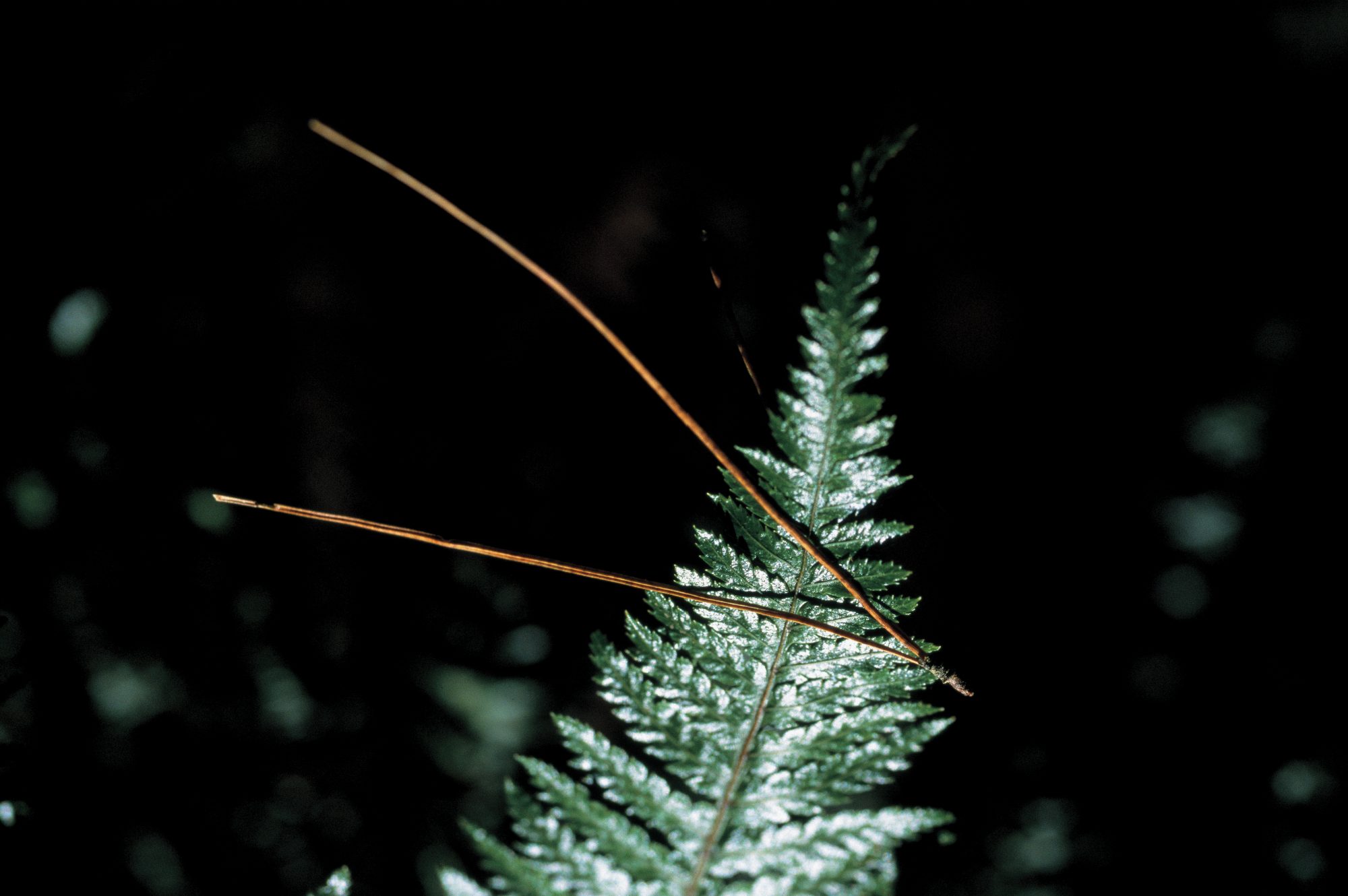
Pine forest natives
Plantations of exotic timber trees, especially pines, are looked on with disdain by many as alien monocultures, an unpleasant accommodation necessary to protect precious indigenous forests from the logger’s chainsaw. Yet a good range of native organisms, untroubled by the trees’ pariah status, are quietly enjoying life beneath the rain of pine needles.
It’s another warm, sunny summer day, ideal for tree growth. Just south of the Waiotapu pub, on the Rotorua-to-Taupo highway, I head into one of New Zealand’s largest pine forests, Kaingaroa Forest, to check my pitfall traps and see how many insects I’ve caught.
After parking the dusty ute and donning the usual high-vis reflective clothing, it’s into the blackberry and gorse that seem to protect the edge of many pine plantations from all but the most curious of people. In the open it’s already hot, but inside the forest it’s cool and damp, with a lush carpet of mosses and ferns underfoot. The first of my insect traps is only a few hundred metres inside; however, along the way there are several diversions. A fantail flitters behind me as I push through increasingly dense tree ferns and small native shrubs. Rotten tree stumps have been heavily damaged by a pig that has spent a recent evening feasting on the huhu grubs within. The remains of last night’s work by the local spiders sparkle with morning dew, and webs strung between trees catch my face.

My first pitfall trap is placed next to a grove of tree ferns. It consists of a plastic cup sunk to ground level with a rain cover and panels that guide ground-dwelling invertebrates to the central collecting pottles. A robin hops along to have a look at my haul of weta, millipedes, beetles, flies and a myriad other creatures. I transfer these to a jar of alcohol for later examination and move on, as I have only five days to check over 400 such traps spread throughout Kaingaroa and Tarawera Forests and some smaller neighbouring plantations. Besides which, Ecki, who is attending to the other half of the trap line in the adjacent compartment, will soon be waiting at the truck, and we still have another 11 trap lines to check before the end of the day.
How rich are our exotic pine plantations in native flora and fauna? It was Ecki who brought the biodiversity value of pine forests to my attention at the start of my studies. In his work in Rotoehu and Kaingaroa Forests (near Rotorua), Hochstetter Forest (on the West Coast) and Eyrewell Forest (in North Canterbury) he found a total of 202 native and 70 introduced plant species in only 60 small study plots. This number of native plants represents almost 10 per cent of New Zealand’s total, a very respectable figure indeed considering the small size of the area assessed. Plant diversity is pretty much confined to the understorey, however, the upper canopy in older stands consisting entirely of pine. So far my insect traps, part of a large-scale project investigating the impact of the size of clearfell harvest areas on invertebrate biodiversity in pine forests, are showing similar results. I’ve found over 350 species of native beetle alone, and the number keeps climbing.
Pine forests are a mosaic of stands of different ages, with recently harvested areas, young trees and mature pines in relatively close proximity. This provides a wide range of habitats, and also helps me to navigate. A forest-establishment map and an eye for different tree heights (and thus ages) allow me to find my way to various sites, despite the maze of unnamed roads that leave first-time visitors disoriented.
Introduced plant species such as buddleia, gorse, broom and grasses tend to dominate in the open—in harvested areas and skid sites (where timber is collected for transportation) and along roadsides—although many natives are also present in these places. This tends to be all that the average passing motorist sees of the country’s pine plantations, which does little for an appreciation of the diversity of native plants in the understorey.
As a plantation ages and successional processes kick in, the proportion of native species begins to increase. By the time the pines are 20 years of age a dense understorey of native shrubs, tree ferns and, in some cases, sub-canopy trees is likely to have developed. As long as moisture is adequate, the low light levels associated with canopy closure give native plants an advantage over exotics such as gorse, which demand more light. As the pines approach maturity the understorey is often very similar to that of nearby native-forest remnants. The dry Canterbury Plains forests, however, such as Eyrewell, have much lower understorey diversity than the wetter forests around Rotorua and on the West Coast.

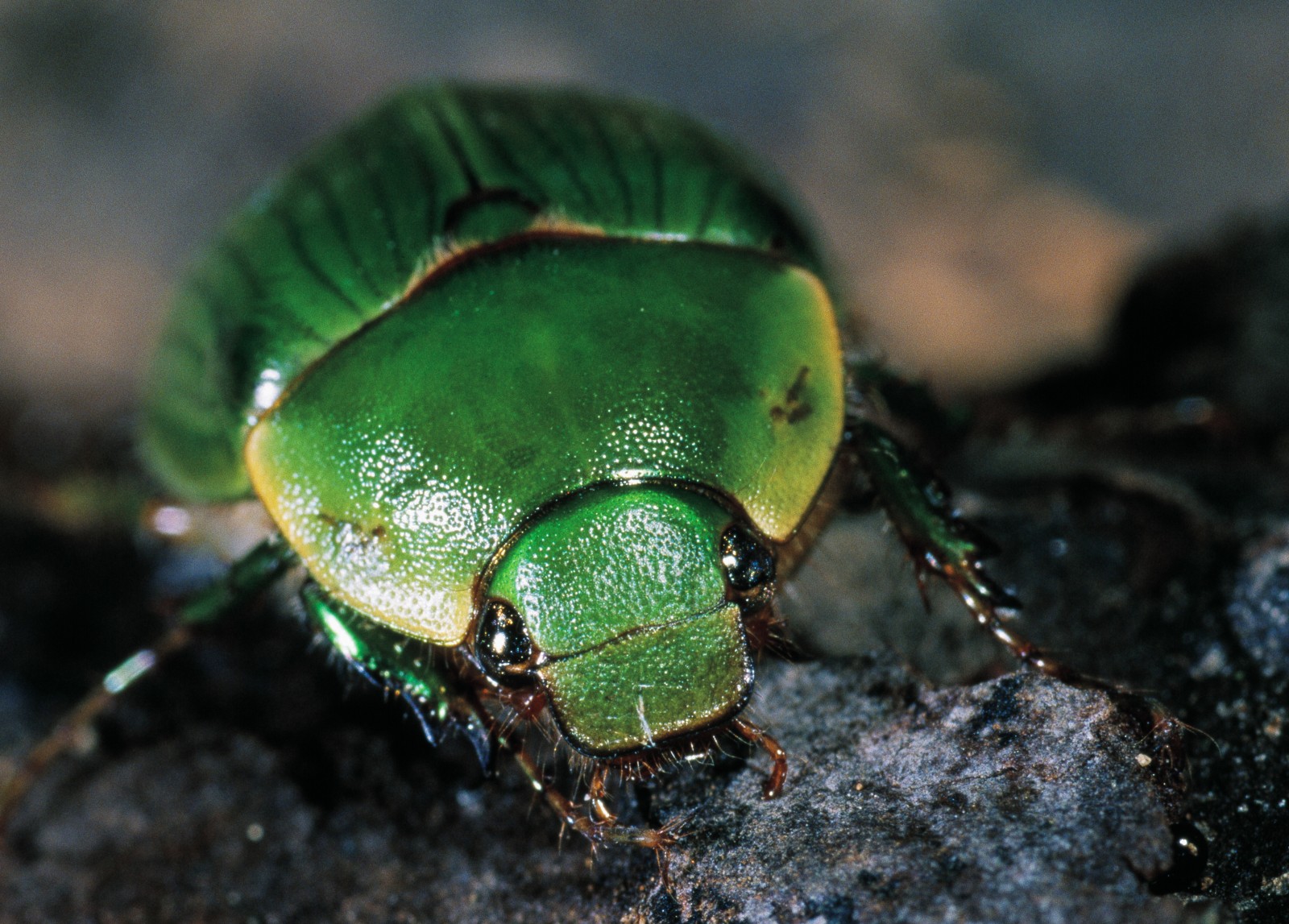
Probably the most conspicuous native plants in pine plantations are ferns, which regularly reach levels of diversity similar to those in adjacent native forest. The large mamaku, or black tree fern (Cyathea medullaris), and our national emblem, the silver fern (Cyathea dealbata), are common in the sub-canopy of many low-altitude North Island pine forests. I regularly do battle with their fronds as I push through to my more distant pitfall traps, although bracken is worse, growing to a height of 2 m at some of my sites.
The densest groves of tree ferns develop in moist gullies, while smaller ferns are ubiquitous. Studies by John Ogden of Auckland University have shown that tree ferns commonly reach densities of 2000–2500 per hectare in the mature pine plantations of the central North Island. Such proliferation is largely a reflection of tree ferns’ dispersal capabilities. Fern spores are readily blown through the landscape, and the canopy of a radiata forest provides an ideal environment for their germination and subsequent growth. Even stands as young as 6 years may have healthy fern populations derived from the regrowth of plants that survived the harvesting process.
Not only are pine forests a haven for common New Zealand native plants, they are home to a number of endangered or threatened species. For example, the native woodrose (Dactylanthus taylorii), a bat-pollinated parasitic plant that grows on the roots of sub-canopy trees (see NZ Geographic, Issue 6), has been found in a pine forest in north Taranaki. An undescribed species of Pomaderris, a genus of indigenous shrubs uncommon in the South Island, is found in relative abundance in Eyrewell Forest. Probably the most fascinating plants to be found in New Zealand’s pine forests, however, are the native orchids.
The Iwitahi Orchid Reserve, established in a corner of Kaingaroa Forest in August 1987, is a small piece of paradise for orchid lovers. Only a few hectares in size, this old-growth Pinus nigra forest, with its deep litter layer and rich fungal flora, supports a staggering 36 species of native orchid, including the only known North Island population of Chiloglottis valida. Not to be outdone, a larch and Corsican and Austrian pine forest near Hanmer Springs, in North Canterbury, is also rich in native orchids. Controversy has recently arisen as a result of large areas of this forest being harvested. Despite the dramatic changes to the landscape, the orchids and other wildlife should return in time. To facilitate recovery, however, foresty companies need to draw up sensible harvesting plans. Thoughtful logging allows indigenous flora to survive in the remaining mature compartments of a forest while regeneration takes place in the younger stands. A chequerboard pattern of stand ages can maximise ecological opportunities and facilitate dispersal between habitats, thereby maintaining (even enhancing) forest biodiversity on a landscape scale.
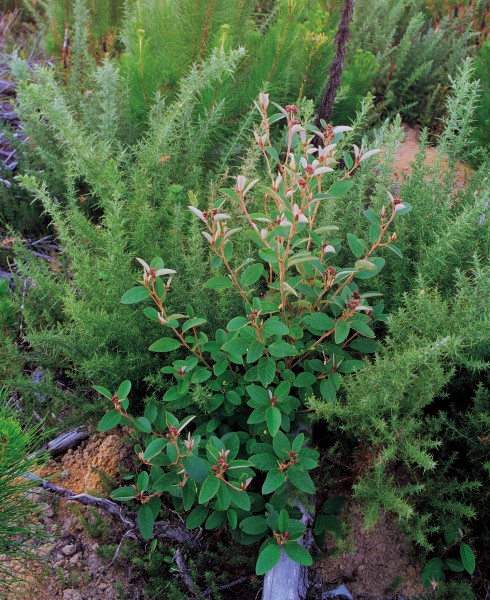
New Zealand’s unique bird fauna is without doubt a main focus of the country’s conservation efforts. On the whole New Zealanders prefer to watch and listen to birds than to observe other animals. If past research is anything to go by, one of the best places to see birds is in your local pine forest.
The earliest records of native birds colonising pine forests were made in the 1940s. By the 1960s, Kaingaroa Forest boasted the highest densities of birds recorded on the New Zealand mainland, with 1203 pairs per 100 ha, 652 of which were native. Such abundance is still noticeable. On warm, fine afternoons, as I walk through Kaingaroa Forest to check my pitfall traps, the chorus of birdsong is unlike anything I’ve heard in other mainland forests. Although the avifauna of pine forests is not as diverse as that of thriving native ecosystems, forest biologist R.W. Jackson recorded 54 native and 26 exotic species in pine forests. Insectivorous birds dominate owing to the abundance of suitable food and the general lack of fruit and nectar as required by other birds, such as tui, bellbirds and kereru. Whiteheads, tomtits, robins and brown creepers are all abundant within their respective ranges, as are a number of introduced species.
Lunchtime in a pine forest is always a good time to observe these birds and presents me with an opportunity to feed the local population of inquisitive robins the odd crumb from my cheese sandwich. However, a couple of my study sites are rather more dangerous places in which to dawdle, being home to breeding pairs of the endangered New Zealand falcon. These birds don’t take kindly to visitors and have been known to force this humble entomologist to run between traps to keep out of their way. Many falcon families have taken up residence in pine plantations, and the species is currently flourishing in the large clearfell areas and young stands of radiata in the central North Island forests. The precise reasons for this success are not known; however, there is an abundance of prey due to the high densities of insect- and seed-feeding songbirds in pine plantations. Falcons are also present in exotic forests elsewhere in the country.
Don Cooper, a retired New Zealand Forest Service technical officer and long-time amateur ornithologist from Nelson, has had a long association with the falcons in nearby Golden Downs forest. Brief glimpses of falcons chasing prey through the trees was about as much as he saw of the birds while working in the forests over 40 years ago. Yet his long-term observations indicate that birds from the finch family make up a large proportion of the falcon diet in Nelson’s exotic forests, and that nearby streams are important preening and bathing sites.
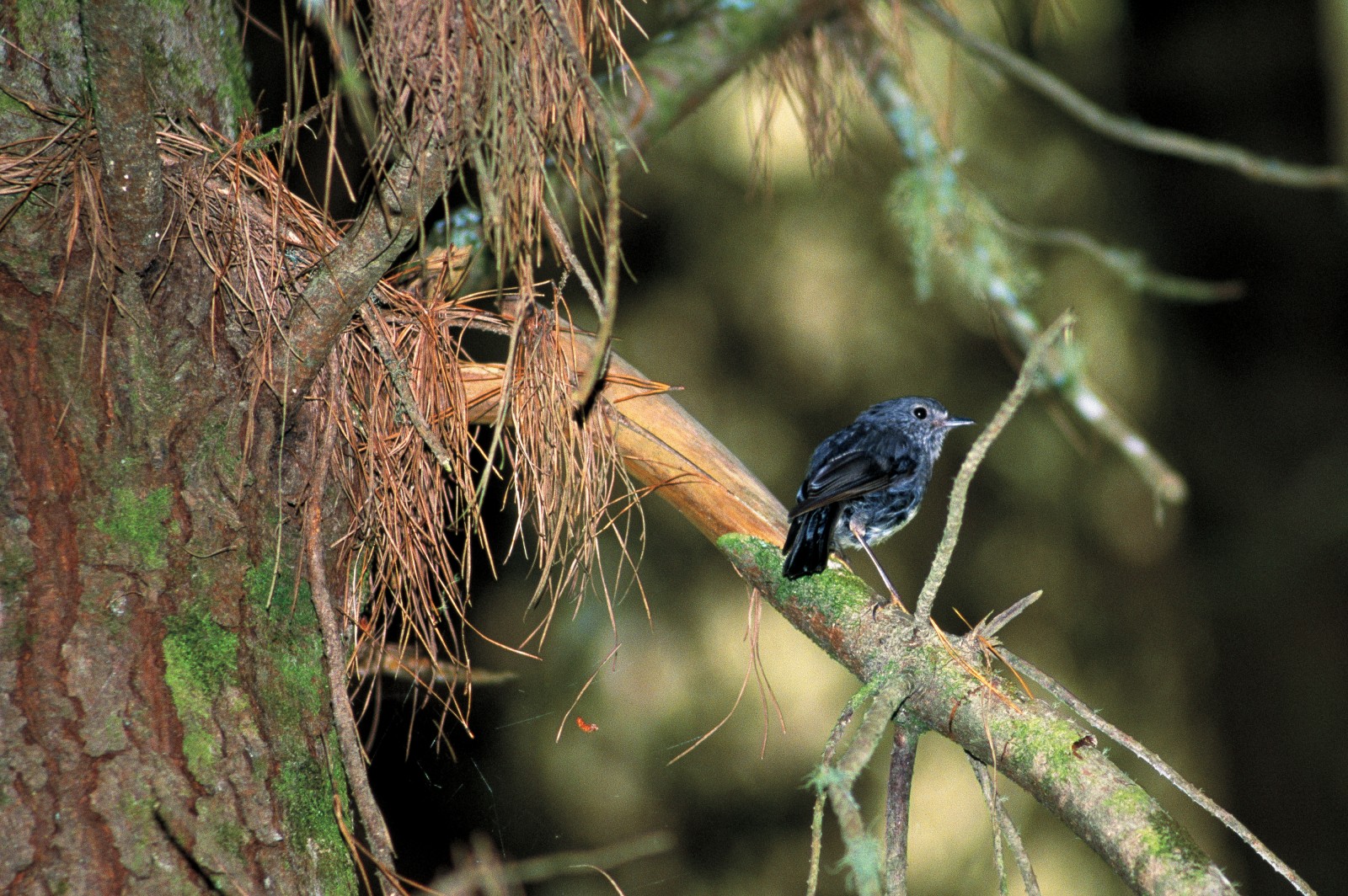
Since spring 2003, Nelson forest owners Weyerhaeuser have discovered numerous falcon nests in recently harvested areas. With a little help from logging crews and plastic tape to keep machinery away from their nests (which are on the ground, among harvesting debris), the falcons have been flourishing. Cooper has witnessed the fledging of numerous chicks from these areas, sometimes as many as three at once, when two is more usual. The falcons’ hunting ground of open scrubland expands as the crews remove yet more trees. If you venture into such an area, don’t forget to wear a hard hat or you might just get a slap on the head from a swooping bird.
Other rare or threatened New Zealand birds are either resident in pine forests or occasionally visit them. These include the rifleman, fernbird and long-tailed cuckoo. Kaka in the Whirinaki region derive a considerable portion of their diet from exotic trees, in particular Douglas fir, from which they strip and eat the bark of the terminal leaders as well as the seeds. Wetlands and streams within plantations also provide habitat for species such as blue duck, Australasian bittern, brown teal, dabchick, banded rail, spotless crake and, perhaps surprisingly, kakapo, kiwi and kokako. Yes, three of our most iconic bird species are quite happy about spending time in pine forests, odd as this may seem.
Kakapo deserve a special mention with respect to pines. It is thought that plant hormones present in green rimu fruit—in the relatively occasional years in which this is abundant—trigger kakapo breeding. These hormones are also present in other developing fruits and plant materials. On Maud Island/Te Hoiere, in the Marlborough Sounds, where some kakapo were kept for a time, one of the birds’ favorite foods was Pinus radiata. Foliage, stems, pollen cones, small green cones, bark—they loved everything. In 1998 two Maud Island kakapo, Flossie and Richard Henry, bred successfully on this diet. From early November 2004 to February 2005, 13 female and 4 male kakapo on Codfish Island/Whenua Hou were fed green pine conelets in an attempt to stimulate breeding. Preliminary results suggest possible success.
[Chapter break]
Birds are the noisiest contributors to the biodiversity in plantations; however, the majority of native organisms in pine forests remain unseen by most visitors. Many invertebrates are active only at night, and the prolific fungal communities are, for the most part, underground. Fungi are for long periods present only as masses of white and yellow hyphae that grow slowly through the deep layers of pine-needle litter and woody debris on the forest floor. However, every year they burst forth with the fruiting bodies we know as toadstools and mushrooms. Brown, red, purple, orange and white, they sprout following periods of rain. Thousands of red- and white-spotted Amanita muscaria can pop up seemingly overnight, imbuing the forest with a magical fairytale quality.
- Ecki Brockerhoff shakes a kanuka tree to dislodge insects onto a collecting sheet. Ecki leads a team studying biodiversity and conservation in plantation forests at the Forest Research’s Centre for Sustainable Forest Management.
- Steve Pawson checks the critters that have had the misfortune to stumble into his preservative-containing collecting jar.
Apart from their attractive—and, in some cases, deadly—fruiting bodies, fungi play a vital role in the health and growth of pine trees. Chemical decomposition of organic matter by the enzymes produced by fungi is integral to the recycling of nutrients in a forest. Some fungi have a symbiotic relationship with trees. These are the so-called mycorrhizal fungi, which live among the tree roots, where they receive shelter from the soil environment and enjoy a ready source of carbon as food. In return, mycorrhizae help trees garner nutrients such as nitrogen and phosphorous, which are essential for growth but often in limited supply.
The prolific growth of fungi and the abundant supply of decaying wood provide ideal habitat and food for many insects. Insect diversity in an individual pine forest could well top 1000 species when beetles, flies, wasps, true bugs and all other insect groups are taken into account.
The huhu beetle is a very common and gastronomically popular denizen of pine forests. As the sun sets and the light fades on warm summer evenings, the drone of their wings as they cruise the forest in search of freshly felled timber is clearly audible. Females lay eggs in recently dead radiata logs or stumps. Once hatched, the grubs proceed to turn the wood into dust before emerging as adults two years later. However, hungry wild pigs, which use their powerful tusks to rip apart such logs in search of a high-protein snack, often interrupt this process.
- Up to 1000 speciesof insect—and that wouldn’t include spiders such as Hemicloea rogenhoferi (above)—are likelyto live in individual pine forests. Since the species found will vary around the country, the total number of native insect species that use pine forests will be considerably higher. The beetle with the fine jaws is a 3.5 cm Placumostethus planiusculus, from Marlborough.
Weta is the common name for several families of native flightless grasshopper. A number of species of ground weta and cave weta are common in pine forests. Cave weta are perfectly at home there, thriving in the damp environment of rotting logs or piles of waste wood produced during pruning or thinning.
Caterpillars of the ghost moth (family Hepialidae, members of which grow up to 10 cm long) spend the nocturnal hours ambling across the forest floor looking for food while trying to avoid becoming food for others. By day they shelter in deep burrows in the litter, protected from predators and the drying sun. As they roam at night, feeding on fallen leaves, they create little swirls in the pine needles surrounding their homes. However, you have to tread very carefully if you want to see one, as they are incredibly sensitive to vibration and quickly retreat underground.
[Chapter break]
Unlike many countries New Zealand has a relatively impoverished native mammal and frog fauna. What few species it boasts are endemic and of international importance. Neither group is commonly represented in plantation forest but specimens from both have been found there. Long-tailed bats have been seen roosting in the decaying boles of old pines, and populations of the scarce Hochstetter’s frog survive in a number of Northland pine forests, where suitable habitat exists along the margins of streams.
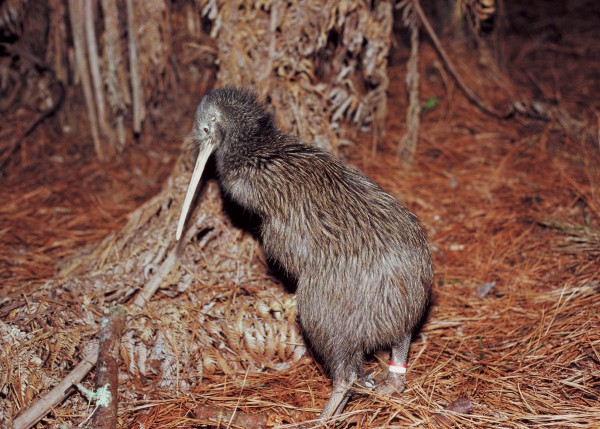
Lorna Douglas, at Northern Poytechnic, began studying Hochstetter’s frogs in 1997 and has been returning to some sites in the pine plantations for the last six years. She has found the majority of frogs are resident in steep gullies that retain some native forest and are buffered from the surrounding agricultural landscape by an encircling pine forest. The gullies provide an ideal habitat, with small waterfalls and cascades and abundant shelter under rocks. Douglas’s research has shown that the frogs are reliant on good shelter and water quality. In most areas water quality is assured by the riparian margin of undisturbed native forest bordering the streams. However, wind-throw events are common due to the underlying soil types in the area, and canopy disturbance from forest harvesting occurs every 25–30 years. These can have an impact on water quality, resulting in periods of stream sedimentation. The good news is that recent monitoring in Carter Holt Harvey’s forests has shown that some frogs survive both wind throw and harvesting and have been found in regenerating stands after logging.
[Sidebar_01]
Native frogs are not the only interesting animals associated with the streams of plantation forests. Compared with some other productive land uses, such as pastoral farming, plantation foresty doesn’t contribute much sediment to streams. Good forestry practices protect riparian vegetation, which stabilises riverbanks and, most importantly, provides shade, preventing an increase in water temperatures. This combination of estabilised banks and shade makes good habitat for many native fish. Several endangered species, such as the giant kokopu and short-jawed kokopu, have been found in streams running through plantations.

Prehuman New Zealand was predominantly a forest landscape; however, much of the original forest has been cleared. In the past plantations were sometimes established on the clear-felled remains of native forest. The New Zealand Forest Accord, signed by most forest owners in the early 1990s, has ensured that new pine plantations are now created by the afforestation of non-forest land, such as marginal agricultural areas. Thus, new plantations now provide a forest habitat and associated microclimate not present under the previous regime of pastoral or arable farming.
For many native species of bird, fungus, insect and plant this is sufficient, as they do not discriminate between native and plantation forest. They benefit greatly from the reforestation of large areas of the country, and as plantations have expanded, so has the habitat available to them. Unfortunately the recent boom in the dairy industry, in combination with a slowdown in the forestry sector, has resulted in commitments to return some large plantations to pasture and other non-forest habitats once the trees have matured and been harvested.

The average rotation of a pine plantation allows insufficient time for most native canopy tree species to mature. Neither do plantations provide the right conditions for some specialist forest dwellers, such as hole-nesting birds. Many native plants and animals depend for their survival on other natives—as hosts (in the case of parasitic species), food sources or pollinators. A lack of these in radiata forests means that some species will never be able to live there.
Many people consider these facts a negative aspect of New Zealand’s pine forests. But while plantations are not native forests and can never be more than a next-best substitute, they do represent a significant proportion of the country’s forest cover and provide many native species with suitable habitat that other productive land uses do not. When assessing the value of pine forests in terms of native biodiversity, we should not base our judgements solely on traditional comparisons of pine plantations with unmodified forests of native species. When plantations are compared with other kinds of productive land use, such as pastoral or arable farming, which allow few indigenous species to thrive, it is clear they have their merits.




















